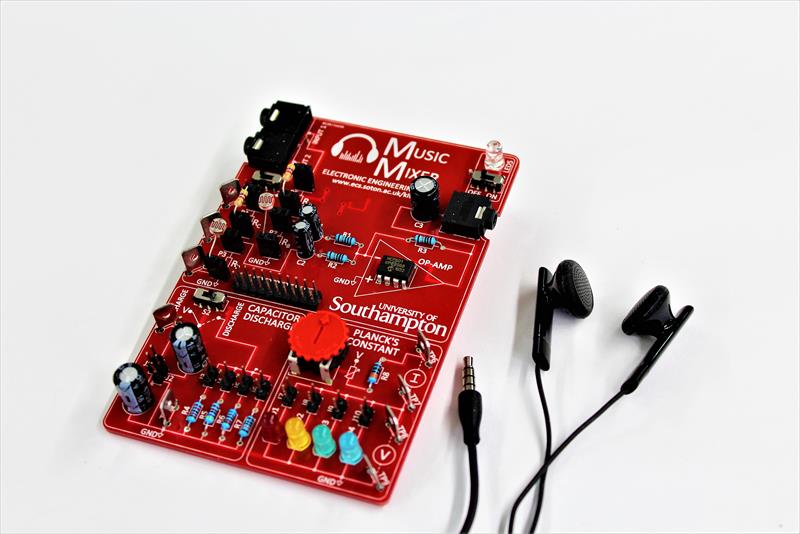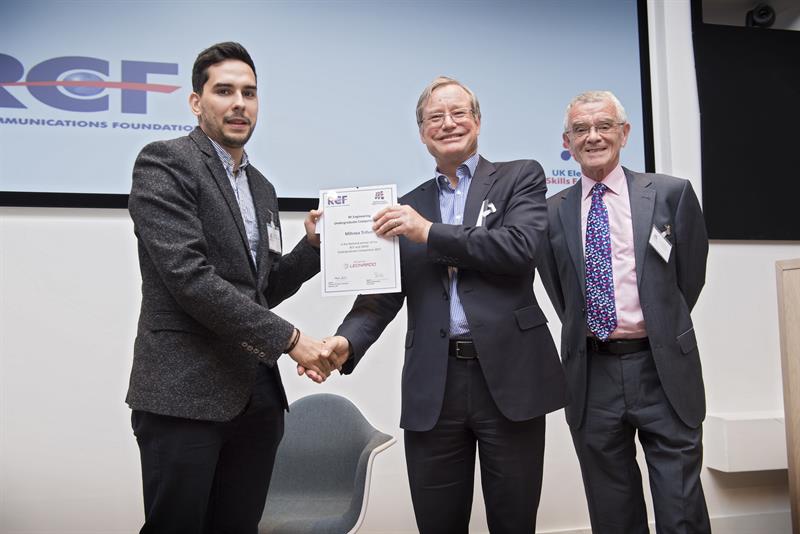A charitable foundation that was set up in 2010 by NMI, Semta, the then Department for Business, Innovation and Skills (now the Department for Business, Energy and Industrial Strategy) and industry partners, UKESF has two main objectives: to support electronics undergraduates; and to reach out to schools to promote electronics.
While the electronics sector is growing strongly and contributes upwards of £100billion to the UK economy, the demand for capable and employable graduates is continuing to significantly outstrip supply.
“We are an educational charity,” explains Stew Edmondson, UKESF’s CEO, “and we work collaboratively with major companies, leading universities and other organisations to try and tackle that skills shortage.
“UKESF works to ensure that more schoolchildren are aware of electronics and the opportunities available to them and to help them to develop their interest through to university study. At university, we look to support undergraduates and prepare them for the workplace.”
Under the UKESF’s scholarship scheme, companies are able to mentor selected students providing a bursary, summer and annual placements, as well as full-time job opportunities.
The UKESF is also involved in organising a week-long training programme of skills development every summer in non-technical areas such as communication, project management and negotiation techniques to better understand the needs of business.
“Every year, I make the students do a presentation after their second week and one at the end of the 13 week placement and the progress I see is quite remarkable,” said Neil Raphael, head engineer at Leonardo MW.
Leonardo MW brings together AgustaWestland, Selex ES, DRS Technologies UK and Finmeccanica UK, with M standing for Marconi and W standing for Westland, recognising its heritage.
“These placements teach them communication and organisational skills, how to work in teams and how a business works,” he said.
As building a network of contacts, students contribute to real projects during their internships and try different roles to get a better understanding of the opportunities available to them in electronics.
Jonathan Bland, the first UKESF undergraduate to join Leonardo’s graduate scheme, was eager to have some practical experience before leaving university.
“It was through my first placement that I discovered that I enjoyed RF and microwave engineering so, when I went back to university, I chose related modules. It helped me decide what I wanted to do in the future,” Bland explained.
The scheme also benefits participating companies, who can profit from extra staffing while, more importantly, training students and helping to shape their skills and ideas, hopefully aligning them in the process to the needs of the business going forward.
“Through our previous experience of placements, we realised they are a great way to find the best people” Raphael added.
“The programme also helps to extend our reach into universities – such as Southampton or Surrey – that we’d not normally engage with.”
Ultimately, the aim is that students will continue to work for the company once they graduate. But Raphael agrees that, even if they don’t, contributing to the workforce pool means they’re more likely to get something back.
Edmondson says the scheme offers a cost effective and easy way to connect students with smaller companies that may not have the necessary resources.
The programme also requires students to commit to promoting electronics at schools.
“The scheme is a symbiotic relationship between the university and the company, with UKESF – and the student – being the glue in the middle,” suggested Raphael. “For example, microwave wasn’t taught at Jonathan’s university; we had to convince them to add it to the syllabus. It means that universities become more attuned to the needs of industry.”
“There’s a disconnect between the output of universities, student expectations and the expectation of the employer. I think our scheme helps to narrow that,” said Edmondson.
Starting with five universities and six companies, the scholarship scheme now includes 18 universities and 40 companies – with Rolls-Royce set to join next year.
“In 2012, just eight scholars graduated; in 2017 there were almost 50,” said Edmondson.
Over the last five years, the scheme has supported almost 400 students, 80% of which are now said to be working in the electronics/technology sector, while 12% are currently studying for PhDs.
UKESF is looking to bring more companies into the scheme, including those in the automotive sector, such as JLR, who are increasingly in need of electronics graduates.
According to Warren East, Rolls-Royce’s CEO, while 50% of the company’s business is now dedicated to aero engines, it also deals in rail and marine technology – all of which are becoming more dependent on electronics.
Speaking at the event, East said: “If we are ever to build an electric aircraft, we have a number of issues to overcome – eliminate failures in electrical systems, reduce the weight of conductors, the cost of electric components and improve the energy density of batteries. Today, batteries are 35 times less effective than kerosene.
“We need a little magic to make the impossible possible. For that, we need to both encourage and nurture a new generation of brilliant engineers. That’s why we decided to join UKESF.”
Competing for talent
Indro Mukerjee, chair of the UKESF steering board, believes there is a risk that UK companies will become uncompetitive because they won’t have the necessary talent. He also believes there is a generational gap, with an older electronics workforce struggling to understand and adapt to new approaches to electronics design.
“The world has changed completely. Young people see electronics as the means – not the end – to save the planet, entertain themselves, communicate, be secure, help other people, cure diseases. It is why the Raspberry Pi was such a success; the idea comes first, the technology second.”
Edmondson has co-written a white paper with Steve Watts, head of electrical and electronics at Cardiff University, which proposes that equal prominence be given to electromagnetic forces as well mechanical forces in the A-level mathematics curriculum.
“An overly heavy focus on mechanical forces explains why students have a bias towards studying mechanical engineering, rather than civil or electrical and electronic engineering, once they are at university,” explained Watts.
Making electronics a core part of the A-level mathematics curriculum will not only make it more visible, but could also encourage more female pupils to take up electronics as they represent 40% of mathematics A-level pupils as opposed to around 22% in physics.
According to UKESF, 69% of companies in the sector complain that a lack of suitable candidates is affecting recruitment and Cardiff University claims it is at only 50% capacity for E&E students.
Building on its experience, UKESF offers five tips to attracting more graduates. Firstly, they need to provide an (honest) profile focusing on the kinds of activities a new recruit would be involved in and how their career could progress with them. They then need to improve the working environment and consider offering additional perks. Companies also need to also offer stimulating assignments to interns and to offer competitive compensation, such as professional qualifications and opportunities for progress and recognition. Finally, they need to use social media as well as attending networking events and recruitment fairs.
 The 'music mixer' kit enables students to mix music using a variety of different sources
The 'music mixer' kit enables students to mix music using a variety of different sources
Pilot project
UKESF is also looking to increase its involvement in schools to promote electronics – focusing on A-level students.
“A recent study from the University of Exeter shows there is no evidence that enrichment activities encourage pupils to study STEM subjects – there is no direct impact on the numbers choosing to study AS or A-levels in these subjects,” Edmondson commented. “We have to be careful that what we’re doing is relevant and has a positive impact.”
UKESF has partnered with the University of Southampton to target pupils who have already chosen to study A-level physics. The project comprises several elements, the first of which is a Continuous Professional Development day event at which state school physics teachers can increase their knowledge of electronics and familiarise themselves with the proposed project. Another is a ‘music mixer’ kit, which enables students to mix music from sources such as smartphones using an op-amp circuit, controlled by potential dividers and various electronics sensors. The intention, according to the kit’s creators Dr Daniel Spencer and Dr Alex Weddell is to introduce students to electronic components and circuits through ‘hands-on’ experiments. This approach is expected to reach more than 2400 students in the coming academic year.
The mixer kit concept is set to be extended and Southampton is looking at targeting computer sciences with a Logic and Arithmetic Kit.
“We believe helping teachers increase their knowledge and understanding of electronics will help them to inspire and encourage pupils to continue with this subject,” said Edmondson.
While the work of the UKESF should be celebrated, the numbers of students studying Electrical and Electronic Engineering is less than the sector in the UK requires and major shortages in the quantity and quality of skills remain a challenge for UK economy.
RF competition winner
The winner of the RF competition was announced from among three finalists. Sheffield University undergraduate Mihnea Trifan won £1000 for his project focusing on 5G and the next generation of wireless communications (see below).
Trifan helped develop an antenna using frequency selective surfaces technology to directly modulate the signal and achieve QPSK modulations, which are said to be an enabler for the 5G.
“In this antenna, we managed to eliminate the mixer and the power amplifier because we did all the modulation and all the mixing of the signals on the antenna,” Trifan explained. “As it’s more integrated, we can replicate the antenna into big arrays – or a huge MIMO, which Nokia and other companies are looking to develop.”

Merv Haynes, UK head of electronics for Leonardo MW, claims RF is core to half of the company’s departments and that one third of UKESF companies are interested in RF.
“RF is essential in semiconductor technology, custom SIGe design, FPGA technology, radar, EW, communications, to make faster clocks and for additive layer manufacturing because of novel RF structures,” he said.
There is therefore a big market for RF skills, but the number of students studying these subjects at university is dropping.
“We’re shining a light on it, but we need universities to offer more courses,” said Edmondson. “For that to happen, we need to show them students are interested, as well as companies.”
In the meantime, Leonardo has decided to do things its way. “As an engineering manager, I spend my life trying to recruit experienced RF engineers and I can’t find them,” said Neil Raphael, lead engineer at Leonardo. “Instead, we’re doing something different – developing them internally."













